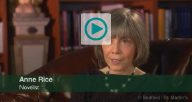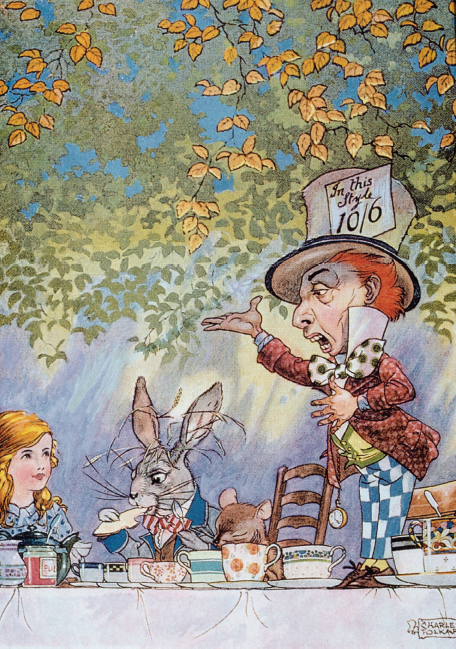Convergence: Books in the Digital Age
“It is exciting to contemplate a future where the cultural heritage of our country is available at your fingertips.”
DAVID FERRIERO, ARCHIVIST OF THE UNITED STATES OF AMERICA, 2011
In 1971, Michael Hart, a student computer operator at the University of Illinois, typed up the text of the U.S. Declaration of Independence, and thus, the idea of the e-book—a digital book read on a computer or a digital reading device—was born. Hart soon founded Project Gutenberg, which now offers more than forty thousand public domain books (older texts with expired copyrights) for free at www.gutenberg.org. Yet the idea of commercial e-books—putting copyrighted books like current best-sellers in digital form—took a lot longer to gain traction.
Print Books Move Online
VideoCentral  Mass Communication
Mass Communication
bedfordstmartins.com/mediaculture

Books in the New Millennium
Authors, editors, and book-store owners discuss the future of book publishing.
Discussion: Are you optimistic or pessimistic about the future of books in an age of computers and e-readers?
Early portable reading devices from RCA and Sony in the 1990s were criticized for being too heavy, too expensive, or too difficult to read, while their e-book titles were scarce and had little cost advantage over full-price hardcover books. It is no surprise that these e-readers and e-books didn’t catch on. Then in 2007, Amazon.com, the largest online bookseller, developed an e-reader (the Kindle) and an e-book store that seemed inspired by Apple’s music industry–changing iPod and iTunes. The first Kindle had an easy-on-the-eyes electronic paper display, held more than two hundred books, and did something no other device could do before: wirelessly download e-books from Amazon’s online bookstore. Moreover, most Kindle e-books sold for $9.99, less than half the price of most new hardcovers. This time, e-books caught on quickly, and Amazon couldn’t make Kindles fast enough to keep up with demand.
Amazon has continued to refine its e-reader, and in 2011 it introduced the Kindle Fire, a color touchscreen tablet with Web browsing, access to all the media on Amazon, and the Amazon Appstore. The Kindle devices are the best-selling products ever on Amazon. Of course, the Kindle is no longer the only portable reading device on the market. Apps have transformed the iPod Touch, iPhone, and other smartphones into e-readers. In 2010, Apple introduced the iPad, a color touchscreen tablet that quickly outsold the Kindle. The immediate initial success of the iPad (introduced at a starting price of $499 and up), which sold three million units in less than three months, spurred other e-readers to drop their prices below $200. Like Amazon’s Kindle Fire, other devices have mimicked the iPad by adding color, e-mail, and an app store.
By 2012, e-books accounted for 20 percent of the trade book market in the United States (in terms of revenue). Projections indicate that e-books will surpass the print book market by 2017.10 But perhaps the best indicator that e-books are here to stay is that the New York Times launched a new weekly e-book best-seller list in February 2011. As the market grows rapidly, several companies are vying to be the biggest seller of e-books. Apple’s iBookstore serves the iPad, iPod, and iPhone exclusively. Amazon and Barnes & Noble sell e-books for their readers but also have apps for other devices so that, for example, an iPad user could buy e-books from their stores. Google started its own e-book store (now Google Play) that enables customers to access its cloud-based e-books anywhere via any device, a feature added by Amazon and Apple.
The Future of E-Books
“But a digital public library is quite a different thing than what Google has undertaken with its attempts to digitize every book ever printed. After all, a digital library won’t be just about storing content, but it will be about making that content accessible.”
AUDREY WATTERS, READWRITEWEB.COM, 2011
E-books are demonstrating how digital technology can help the oldest mass medium adapt and survive. Distributors, publishers, and bookstores also use digital technology to print books on demand, reviving books that would otherwise go out of print and avoiding the inconveniences of carrying unsold books. But perhaps the most exciting part of e-books is their potential for reimagining what a book can be. Computers or tablet touchscreens such as an iPad can host e-books with embedded video, hyperlinks, and dynamic content, enabling, for example, a professor to reorganize, add, or delete content of an e-textbook to tailor it to the needs of a specific class. Children’s books may also never be the same. An Alice in Wonderland e-book developed for the iPad uses the device’s motion and touchscreen technologies to make “the pop-up book of the 21st-century.” Such developments are changing the reading experience: “users don’t just flip the ‘pages’ of the e-book—they’re meant to shake it, turn it, twist it, jiggle it, and watch the characters and settings in the book react.”11 E-books have also made the distribution of long-form journalism and novellas easier with products like the inexpensive Kindle Singles.
